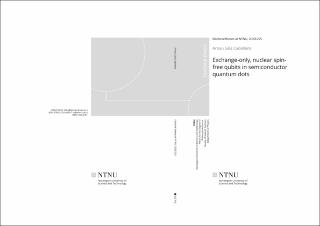| dc.contributor.advisor | Danon, Jeroen | |
| dc.contributor.advisor | Linder, Jacob | |
| dc.contributor.author | Cadellans, Arnau Sala | |
| dc.date.accessioned | 2020-10-12T11:30:25Z | |
| dc.date.available | 2020-10-12T11:30:25Z | |
| dc.date.issued | 2020 | |
| dc.identifier.isbn | 978-82-326-4859-7 | |
| dc.identifier.issn | 1503-8181 | |
| dc.identifier.uri | https://hdl.handle.net/11250/2682234 | |
| dc.description.abstract | There are many successful proposals for using electron spins in quantum dots as qubits. However, a semiconductor quantum dot-based qubit that is scalable, reliable and robust enough for actual quantum information applications has not been realized yet. Common problems in semiconductor quantum dot-based spin qubits are (i) the manipulation and coupling of spin states in a scalable way and (ii) the decoherence of the qubit. While the first problem has been overcome with the so-called exchange-only qubit, the second problem is still hindering the progress towards large-scale quantum computation using quantum dot-based spin qubits.
In this regard, we propose a feasible and scalable exchange-only spin qubit composed of four quantum dots that is, to leading order, intrinsically insensitive to randomly fluctuating magnetic noise, while still offering a full electric control. Motivated by our findings, we then analyze in full detail the main relaxation mechanisms in exchange-only spin qubits composed of three and four dots, and find the regimes where the coherence time of the qubit can be extended by several orders of magnitude. We then explore the possibility of implementing our proposal for an exchange-only qubit in a device composed of three quantum dots—which would offer an unprecedented degree of tunability—and in an already existing device with five quantum dots, proving that a straightforward implementation of our proposal is feasible.
We conclude this project with a thorough analysis of a common electric dipole spin resonance (EDSR) experiment in a system composed of two quantum dots with intrinsic spin-mixing mechanisms. EDSR is a broadly used tool for spectroscopy of quantum dots, yet a detailed theoretical analysis of the physics of an electrically driven system of quantum dots at resonance is still lacking. | en_US |
| dc.language.iso | eng | en_US |
| dc.publisher | NTNU | en_US |
| dc.relation.ispartofseries | Doctoral theses at NTNU;2020:255 | |
| dc.relation.haspart | Paper 1: Sala, Arnau; Danon, Jeroen. Exchange-only singlet-only spin qubit. Physical review B (PRB) 2017 ;Volum 95.(24) s. 1-5 | en_US |
| dc.relation.haspart | Paper 2: Sala, Arnau; Danon, Jeroen. Leakage and dephasing in 28Si-based exchange-only spin qubits. Physical review B (PRB) 2018 ;Volum 98.(24) s. 245409-1-245409-9 | en_US |
| dc.relation.haspart | Paper 3: Sala, Arnau; Qvist, Jørgen Holme; Danon, Jeroen. Highly tunable exchange-only qubit in a GaAs triple quantum dot. Physical Review Research, 2020. Volum 2, 012062(R) | en_US |
| dc.title | Exchange-only, nuclear spin-free qubits in semiconductor quantum dots | en_US |
| dc.type | Doctoral thesis | en_US |
| dc.subject.nsi | VDP::Matematikk og Naturvitenskap: 400::Fysikk: 430 | en_US |
